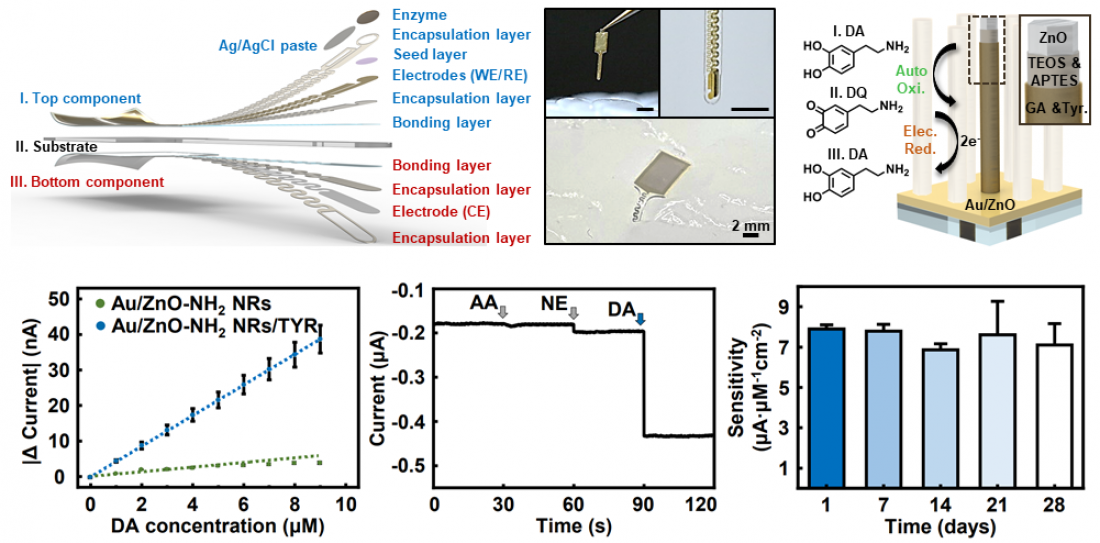□ A research team led by Jang Kyung-in, a Professor affiliated to the Department of Robotics and Mechatronics Engineering at DGIST (President: Kuk Young), developed a dopamine measurement device that can precisely analyze dopamine concentration in real time while minimizing brain damage. As the developed device facilitates accurate real-time dopamine measurements by using only one flexible brain-implantable probe,[1] it is expected to be used as a core technology for developing customized probes for patients with degenerative brain diseases.
□ Dopamine is a crucial neurotransmitter which is widely distributed in the central nervous system and which is associated with brain functions — such as motivation, memory, and reward. When dopamine concentration in the brain is abnormally high or low, it can cause degenerative brain diseases. For this reason, it is important to measure dopamine concentration in the brains of patients suffering from brain diseases to diagnose and treat brain diseases.
□ However, existing brain-implantable probes have problems in that at least two probes are required for dopamine measurement and that their stiff structure is inappropriate for soft brain tissue. Because of these problems, existing brain-implantable probes may cause damage to, or inflammation in, brain tissue, disturbing the ability to consistently and accurately measure dopamine levels. Researchers have proposed technologies for developing brain-implantable probes based on flexible devices; however, these technologies still require either large probes or the insertion of multiple probes, which can lead to significant brain damage.
□ To overcome the limitations of existing probes, Prof. Jang’s research team developed a technology that facilitates dopamine measurement by safely and stably inserting only one flexible probe for the long term. The proposed probe has a double-sided structure, with working and reference electrodes installed on one side and a counter electrode installed on the other side. Based on this structure, the proposed prob provides a measurable area approximately twice as large as that of existing probes (based on a single surface structure) while maintaining the same insertion area.
□ Moreover, the specific surface area of the proposed probe was significantly expanded through the implementation of a complex three-dimensional nanorod structures based on zinc oxide (ZnO) in the working electrode. Therefore, the proposed technology is regarded as a new probe-based dopamine sensor that minimizes damage to brain tissue and maximizes probe functions. When electrodes are located on both sides of a probe, distance between the probe’s neutral layer and the electrodes increases. This structural limitation leads to a mechanically unstable condition of electrodes at the time of probe modification. To solve this problem, Prof. Jang’s research team designed a serpentine-patterned microelectrode that can contribute to the mechanical stability of electrodes, despite their modification.
□ Prof. Jang has stated that “the developed probe based on the double-sided structure facilitates highly precise and stable long-term dopamine concentration measurement, which was not achieved by the use of existing probes. It has the potential to serve as a standard for probe development to support patients with brain diseases.” He also added that “the precision and stability of the developed probe were verified through experiments on mice. We will conduct further research to introduce more enhanced brain-implantable probe technology that can increase the satisfaction of patients with brain diseases throughout their lives.”
□ Park Jeong-rak, a student currently enrolled in the doctoral degree program at DGIST, Jung Han-hee, a doctor, and Ha Jeong-dae, a student currently enrolled in the joint master’s and doctoral degree program at DGIST, joined as the first authors of the research paper on the developed probe. Prof. Jang and Professor Oh Yong-seok at DGIST joined as joint corresponding authors, and Keum Ho-hyun, a doctor affiliated to the Korean Institute of Industrial Technology, as a co-author. This research paper was featured on the cover of the October issue of Advanced Functional Materials, an international academic journal, and published online.
- corresponding author e-mail address : [email protected]
[1] Probe: It refers to a device or tool inserted generally for investigation or measurement or a small sensor or tool inserted in brain tissue to measure dopamine concentration in the brain.



